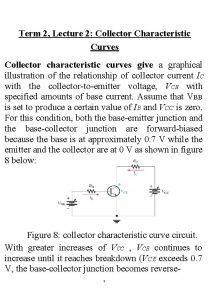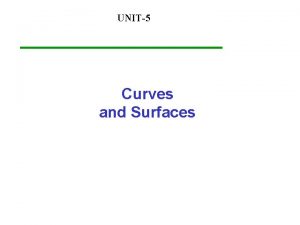Term 2 Lecture 2 Collector Characteristic Curves Collector







- Slides: 7

Term 2, Lecture 2: Collector Characteristic Curves Collector characteristic curves give a graphical illustration of the relationship of collector current IC with the collector-to-emitter voltage, VCE with specified amounts of base current. Assume that VBB is set to produce a certain value of IB and VCC is zero. For this condition, both the base-emitter junction and the base-collector junction are forward-biased because the base is at approximately 0. 7 V while the emitter and the collector are at 0 V as shown in figure 8 below: Figure 8: collector characteristic curve circuit. With greater increases of VCC , VCE continues to increase until it reaches breakdown (VCE exceeds 0. 7 V, the base-collector junction becomes reverse 1

biased and the transistor goes into the active, or linear, but the current IC remains about the same in the linear region from 0. 7 V to the breakdown voltage as shown in Figure 9 below: 2

Cutoff When IB = 0, the transistor is in the cutoff region of its operation. This is shown in Figure 10 with the base lead open, resulting in a base current of zero. Under this condition, there is a very small amount of collector leakage current, ICEO, due mainly to thermally produced carriers. Because ICEO is extremely small, it will usually be neglected in circuit analysis so that VCE = VCC. In cutoff, Base-emitter( Vbe < o. 7 V) and base-collector junctions are reversebiased. The subscript CEO represents collector-toemitter with the base open. In cutoff, the transistor appears as an open circuit between the collector and emitter terminals. Figure 10: Cutoff: Collector leakage current (ICEO) is extremely small and is usually neglected. Base-emitter and base-collector junctions are reverse-biased. 3

Saturation: As IB increases due to increasing VBB, IC also increases and VCE decreases due to the increased voltage drop across RC (VCE = VCC - IC* RC). This is illustrated in Figure 11. When VCE reaches its saturation value, VCE(sat), the base-collector junction becomes forward-biased and IC can increase no further even with a continued increase in IB. At the point of saturation, the relation is no longer valid. VCE(sat) for a transistor occurs somewhere below the knee of the collector curves. Base-emitter and base-collector junctions are forward-biased. In saturation, the transistor appears as a near short circuit between the collector and emitter terminals. Figure 11: Saturation: As IB increases due to increasing VBB, IC also increases and VCE decreases due to the increased voltage drop across RC. When the transistor reaches saturation, IC can increase no further regardless of further increase in IB. Base-emitter and base-collector junctions are forward-biased. 4

Once IC is reaches to maximum value, the transistor is said to be in saturation. Note that saturation can be determined as follows: VCE = VCC – IC* RC , in saturation VCE is very small Vce <= o. 2 V, assume it = 0. IC(sat) = VCC/RC Using the two states of cutoff and saturation, the transistor can used as a switch. DC Load Line Cutoff and saturation can be illustrated in relation to the collector characteristic curves by the use of a load line. Figure 12 shows a dc load line connecting the cutoff point and the saturation point. The bottom of the load line is at ideal cutoff where IC = 0 and VCE = VCC. The top of the load line is at saturation where IC = Ic(sat) and VCE = VCE(sat). In between cutoff and saturation along the load line is 5

the active or linear region of the transistor’ operation. Figure 12: DC load line on a family of collector characteristic curves illustrating the cutoff and saturation conditions. Example: 6

Review Questions: 1. What two variables are plotted on a collector characteristic curve? 2. What bias conditions must exist for a transistor to operate in cutoff region? 3. Explain the cutoff region? 4. What bias conditions must exist for a transistor to operate in saturation region? 5. Explain the saturation region? 6. For a given type of transistor, can beta dc be considered to be a constant? 7













